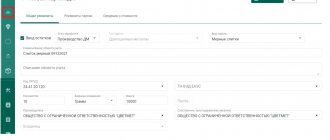According to resolution No. 270-P, from January 1 to January 15, 2022
organizations must enter data on the balances of precious metals and precious inserts into the GIIS DMDK.
Data must be provided based on the results of the inventory as of January 1, 2022. Until April 1, 2022,
organizations will have the opportunity to adjust data on balances in the GIIS DMDK.
Data on balances are provided to the GIIS DMDK in aggregated form. The degree of aggregation is not regulated by any regulatory documents.
Minimum details for entering balances (maximum reduction) for precious metals:
- Type of metal
- Sample
- OKPD2
- Owner (Committent)
- Owner
- Manufacturer
- Number of products
- Product weight
- Weight without inserts
- Chemically pure weight (Product weight without inserts * Sample / 999.9)
- Number of precious inserts
Minimum required set for establishing balances on precious inserts:
- Insert type
- Owner (Committent)
- Owner
- Manufacturer
- Number of inserts
- Weight of inserts
OKPD2
In the GIIS DMDK, a generalized element has been added to the insert type directory - Precious inserts.
This means that, in theory, all balances of precious inserts can be entered in one line by selecting a generalized element (Precious inserts).
But the system requires mandatory completion of the OKPD2 field. But in the OKPD2 directory there is no such general element; all precious inserts have “personal” meanings. How to enter balances for precious inserts - in one line, breaking them down by type of stone or by package - everyone decides for themselves. We can only note that the GIIS DMDK does not yet have a check for the correct filling of the OKPD2 - Stone type link
.
To understand how the GIIS DMDK works, understand the “terminology” of the developers:
The consignment
- jewelry, semi-finished product or metal in any form. The party must have a unique UIN or INP. The “tabular part” of the specification consists of batches. Based on the movement of lots, the movement of precious metals is registered in the GIIS DMDK.
WIN
- “unique identification number” - a unique sequence of numbers generated by GIIS DMDK for individual accounting of jewelry, standard and measured bars in GIIS DMDK, as well as for generating a two-dimensional bar code for jewelry;
INP
— “batch identification number” is a unique sequence of numbers generated by GIIS DMDK to ensure traceability of product turnover in GIIS DMDK. By means of a batch identification number, product identification is ensured in order to control its circulation.
UIN - for one product (standard or measured ingot).
INP - for a batch of semi-finished products, metal, precious stones.
It is important to know and understand: when registering initial balances, an INP is always assigned, even a batch describes a unique, single product. Products with a UIN (and finished products must always have a UIN) are registered only from a batch of UIN entered as residuals.
1. You cannot immediately obtain a UIN for leftover finished products. All balances, even if they are entered individually, must be assigned an INP.
2. For finished products declared as residuals, the UIN is issued only on the basis of the quantity indicated in the batch IIN (line.)
Which option should I choose?
Preferable, of course, is full integration (if we do not consider single production), but... GIIS DMDK developers are late in implementing methods for entering balances in the integration service
.
In the most optimistic scenario, the first releases from vendors, with support for loading leftovers, will be ready in early December. Taking into account that more than 18 thousand organizations have registered electronically with the FPP, it becomes clear that it is physically impossible to update all users’ programs before the New Year
.
Plan B
comes to the rescue - a combined option.
Procedure for choosing Plan B:
1. From January 01 to January 15, 2022
— preparation of “aggregated” data on balances for manual entry through your personal account.
2. When registering balances, it will be necessary to save data on all entered batches and INP in the accounting system (or xls).
3. We update our system as the integration module is ready and technically possible (queue).
4. From January 15 to March 1, 2021
We correct information about transferred balances through the integration service.
5. Through integration, based on registered INNs, we obtain a pool of UINs ( the algorithm is the same as for integration
).
6. We assign the correspondence ShK - UIN (save in the program) and send the data to GIIS DMDK ( the algorithm is the same as for integration
).
The most undesirable option is Plan C - work entirely through your personal account:
1. Preparation of “aggregated” data for entering information about balances “manually” through your personal account
.
2. Request for a pool of UINs for a batch of UIN balances in your personal account on the GIIS DMDK website
.
3. Registration of the finished product with UIN and description of precious inserts in your personal account on the GIIS DMDK website
.
Cons of Plan C:
1. Huge waste of time.
2. It is not clear how to print an additional tag.
3. It is impossible to transfer the UIN when registering a retail sale through UTM ( retail sales through a personal account are not provided
).
Instructions for working in your personal account can be found on the GIIS DMDK website
.
Instructions for entering initial balances in JewelerSoft programs through the integration service.
Sorting out leftovers, working during the transition period
According to Resolution No. 270 of February 26, 2021: clause 11 Establish that from March 1, 2022
.
on the territory of the Russian Federation: ... jewelry
made of precious metals ...
with the exception of
jewelry ...
declared as remnants, must have
a unique identification number assigned to each such product, ... as well as
a label attached to the product
, issued in accordance with the Rules.
item 10... Jewelry
made of precious metals...
declared as residuals must,
by
September 1, 2022
, have a unique identification number assigned to each such product... as well as
a label attached to the product
, issued in accordance with the Rules.
Precious metals
To provide information about the balances of precious metals, it is necessary to register a batch of DM from the section “Batches” - “Precious Metals” indicating the attribute “Enter balances” (see Figure 208 page 153 of the USER GUIDE OF THE ORGANIZATION-PARTICIPANT OF GIIS DMDK dated 12/23/2021).
1. The “Index” field is required ; the serial number of the accounting object is indicated in the form for entering information about the balances of precious metals.
2. The field “Name of batch” is required ; the short name of the accounting object is indicated, which unambiguously characterizes the product described in the accounting object.
3. In the “Batch Description” field, you can specify an additional text description of the accounting object if necessary.
4. The “Batch Type” field is required , the value “Precious Metals” must be indicated.
5. The “Type of batch” field is required ; it is recommended to indicate the most appropriate value from the following list of values: “Mineral raw materials”, “Recycled raw materials”, “Standard ingots”, “Measured ingots”, “DM products (granules, strips) , powders, etc.)", "Intermediate product of metallurgical production", "Scrap, waste".
6. The field “Processing stage” is required ; it is recommended to indicate the value corresponding to the process for which the registered balances of precious metals are intended, from the following list of values: “Production of metal products”, “Processing”, “Manufacture of products”, “Purchase”, “Restoration”, “Turnover on the territory of the Russian Federation”, “Import into the territory of the Russian Federation”.
7. The “Stage” field is required , the value “In storage” is indicated.
8. The “Status” field is required , the value “Initial input” is indicated. This field is required to be filled out by January 15, 2022.
9. The field “OKPD2 code” is required ; the classification of the accounting object is indicated in accordance with “OK 034-2014 (KPES 2008). All-Russian classifier of products by type of economic activity”, approved by order of Rosstandart dated January 31, 2014 No. 14-st) (hereinafter referred to as OKPD2). If there is no suitable OKPD2 code, but there is a more general value suitable for categorizing an accounting object, you should select the appropriate OKPD2 code.
10. The “Manufacturer” field is required ; details of the participant who is the manufacturer of the accounting item or details of the participant from whom the import accounting item was received are indicated. If specifying the organization’s details is impossible due to the selected stage of processing or type of accounting object, the value “Not installed due to lack of information before the implementation of GIIS DMDK” is indicated.
11. The “Owner” field is required to be filled in ; the details of the participant who is the owner of the accounting object are indicated: if the product belongs to you by right of ownership, indicate your organization; if the product is on commission, indicate your principal. If specifying the organization’s details is impossible due to the selected stage of processing or type of accounting object, the value “Not installed due to lack of information before the implementation of GIIS DMDK” is indicated.
12. The “Owner” field is required ; the details of the participant who physically has the accounting object are indicated, that is, the participant who enters information about the balances of precious metals in the GIIS DMDK.
In the GIIS DMDK system, the field will be automatically filled in with the details of the organization under the account (electronic key) you logged into the system.
13. The “Quantity” field is conditionally mandatory ; the number of units of products that make up the accounting object is indicated. Optional if the accounting objects cannot be specified individually.
14. The field “Unit of measurement” is required ; the physical unit used to measure the mass of the accounting object is indicated in accordance with the international designation code “OK 015-94 (MK 002-97). All-Russian Classifier of Units of Measurement”, approved by Decree of the State Standard of Russia dated December 26, 1994 No. 366 (hereinafter referred to as OKEI).
15. The “Ligature mass” field is required ; the ligature mass of the accounting object is indicated. If the object of accounting is a solution, the volume must be converted into mass by the participant who enters the information into the GIIS DMDK.
16. The “Nugget code” field indicates the code of the precious metal nugget in accordance with the organization standard STO 45866412-12-2014 “Nuggets of precious metals. Classification. Control methods, labeling, packaging and storage.” This field is required for nuggets before September 1, 2022.
17. The “Precious metal grade” field indicates the metal grade in accordance with GOST 28058-2015, GOST 28595-90, GOST 12341-81, GOST 12340-81, GOST 30649-99 (jewelry alloys), Enterprise Standards, Enterprise Specifications. This field is required to be filled out for standard and measured ingots, jewelry alloys before September 1, 2022.
18. The “Year of issue” field indicates the year of manufacture of the standard or measured ingot. This field is required for standard and measured ingots until September 1, 2022.
19. The “Ingot number” field indicates the number printed on a standard or measured ingot. This field is required for standard and measured ingots until September 1, 2022.
20. The “Sample” field is required ; the quantitative content of the main precious metal in the alloy is indicated. The value is indicated in thousandths.
21. The “Type of precious metal” field is required ; a classification attribute reflecting the type of precious metal (gold, silver, platinum, palladium, iridium, rhodium, osmium, ruthenium) is indicated. This field can contain several values depending on the amount of precious metals in the accounting object.
22. The “Chemical mass” field is required ; the chemically pure mass of the precious metal is indicated.
What does this mean in practice?
From March 1, 2022
year, all jewelry sold (wholesale or retail)
must have an assigned UIN
. Jewelry not declared as remnants (issued after January 15, 2022) must have a “tag attached to the product in accordance with the Rules” by March 1.
From September 1, all jewelry must have a label “affixed to the product in accordance with the Rules.”
The main thing is to receive UINs before March 1, 2022, both for leftovers and for products received after January 15, 2022 and that do not yet have UINs. All finished products in accounting systems have a unique internal barcode. It is necessary to assign a one-to-one correspondence: internal barcode = UIN
. According to this correspondence, it will be possible to transfer the UIN of the jewelry to the GIIS DMDK by scanning only the internal barcode. Even if the jewelry does not have a label, with a printed UIN (remember, the scheme can only work until September 1, 2022).
Labeling work at different stages of circulation
Participants in the jewelry and precious metals market perform various actions with markings characteristic of the type of activity of the enterprise.
Let's take a closer look at each of them.
Mining companies:
- form production batches;
- send a request to Goznak, receive codes and label each package;
- labeled raw materials are shipped.
Raw materials are shipped to refineries , enterprises with which a toll agreement has been concluded, or to product . In the latter case, property rights are transferred.
Manufacturers:
- receive finished raw materials;
- create blanks for the production of jewelry ;
- send them to the Federal Assay Office (FAP) to identify compliance;
- produce jewelry ;
- send finished goods to the FPP for approval;
- order markings and apply them to labels.
When registering a product in GIIS DMDK, they provide information about the batch of raw materials from which the product .
Jewelry processors and manufacturers :
- receive the marked goods;
- manufacture products in compliance with requirements;
- send it to identify correspondence in the FPP;
- order labeling for each unit of goods;
- place markings on tags and packages.
Refineries : _
- purify precious metal from impurities;
- The received products are sent to the owner.
The owner confirms the fact of practical receipt in the GIIS DMDK.
Wholesale customers:
- register the fact of receipt of products ;
- distribute goods to retail outlets.
Retail Stores:
- accept finished labeled products into the jewelry store;
- record the transfer of ownership rights in the GIS;
- remove the product from circulation by scanning the markings at the checkout when selling to the end consumer.
The online cash register sends information about the sale to the fiscal data operator. From there, the data is transferred to the information system for accounting for precious metals and stones .
You can purchase online cash registers, printers, 2D scanners, label printers and other additional equipment for working with labeled goods in our online store. In addition, the buyer will find in the catalog ready-made solutions for his business and technical support services.
Pawnshops
Submit an application to receive DataMatrix codes and, upon receipt, mark the products .
What are the requirements for label design?
According to the Rules for the functioning of the state integrated information system in the field of control over the circulation of precious metals, precious stones and products made from them at all stages of this circulation:
"P. 34 A two-dimensional bar code, a unique identification number and a website address on the Internet for obtaining information about a specific piece of jewelry through a unique identification number are applied to a tangible medium in the form of an additional tag or label attached directly to the piece of jewelry with a price tag and tag or label, designed in accordance with OST 117-3-002-95
.
In the event that a two-dimensional bar code ... is applied to a price tag
attached directly to such a product,
no additional tag or label is required
.”
Conclusions:
1. For each piece of jewelry, the following information must be printed: DM code, digital code (16 characters) and a link to the website dmdk.ru
2. Information can be printed on a price tag, which is then attached to the product, or on an additional tag issued in accordance with OST 117-3-002-95.
Note:
According to clause 1.2.2.6 of OST 117-3-002-95, “Labels to products must be attached with threads and sealed.
The seal must have a clear imprint of the manufacturer.” In a retail network, when sorting leftovers, it will be difficult to attach an additional tag with the manufacturer’s imprint
.
How the price tag should be attached to the jewelry (with a stapler, thread) is not regulated.
Attention!!!
Printing tags and price tags requires different equipment.
To print a price tag, a regular laser printer is sufficient; for tags, you need a label printer. Make your decision based on economic feasibility.
Which jewelry items are subject to labeling?
Gold , precious stones should be marked , namely:
- gold and platinum jewelry ;
- gold coins ;
- cut and rough diamonds;
- diamonds, sapphires, emeralds and rubies;
- platinum and palladium powder.
Silver and silver goods , as well as products whose weight does not exceed three grams, are exempt from mandatory marking
Options for cleaning residues:
1. Distributed.
An additional tag is printed for all products in each salon.
The tag is hung on jewelry in the showroom. The big disadvantage is that you need a printer for every salon. Once all residues have been cleaned, there will be no need for the printer
.
2. Centralized.
At the central office, additional tags are printed for all products in the retail network and sent to showrooms.
In showrooms, employees attach additional tags to the “necessary” products. The tag with the DM code requires information on the product (article number, weight, size). The best option is to develop a special software assistant that will help the store employee quickly find the right product
.
How to mark jewelry
Two hallmarks are applied to jewelry The first is fineness, which means the amount of base noble metal content. The second is a print with encoded information about the manufacturer, the date of manufacture of the product and the territorial inspection to which the manufacturer belongs.
On March 1 , 2022, jewelry products will be marked with an additional tag with a Data Matrix code and identification number.
And from March 1, 2023, the Data Matrix code will look like a nanotag. The new imprint will be placed on each individual piece and precious insert of the jewelry and will not be visible to the buyer. The size of such a mark will be 0.8 mm2. Entrepreneurs are freed from purchasing expensive equipment. Responsibility for applying nanoengraving rests with the FPP. The department will put marks on jewelry along with the hallmark.
Be careful during the “transition” period.
From the date of provision of information on balances (01/01/2022) until the date of mandatory provision of information on turnover to GIIS DMDK (01/03/2022), a “transition” period applies.
- During this period, newly arriving products may or may not have a UIN.
- Products without UINs received from 01/01/2022 to 03/01/2022 must be marked before 04/01/2022.
- The arrival of products with already assigned UINs must be confirmed in your personal account. Even if you have not yet established accounting for UINs.
- If the arrival of products with assigned UINs is not confirmed in your personal account (within 3 days), then the UIN for these products will need to be requested and printed again. And the problem will be to understand which UINs are “burned out” and which are not. It’s sad if “burnt” UINs are discovered only during implementation.
Advice on decorating a new arrival of jewelry.
Fill out the tabular part of the Item Characteristics.
Configure the processing of loading jewelry from the manufacturer so that the tabular part is filled out.
Many manufacturers indicate inserts in the finished product line by line. Be sure
preparation of information systems, insert classifier
GIIS DMDK has its own structure of reference information. To send information, you need to compare data from your accounting systems with the GIIS DMDK directories.
For example, to register a batch of jewelry you must fill out:
- Batch type
- Party type
- Processing stage
- OKPD2 code
In addition, such a detail as a unit of measurement must be filled out in accordance with the international designation code OKEI, and the currency detail - according to the All-Russian Currency Classifier (OKV).
Example of a reference book: Types of batches in JewelerSoft software products
DataMobile software: solution for transition to jewelry labeling from 2022
DataMobile Labeling is an application for automating the accounting of any labeled products, including jewelry. The program can be installed on mobile devices running Android OS :
- TSD;
- smartphones (working in conjunction with a barcode scanner).
The application allows you to automate any warehouse processes right out of the box:
- acceptance;
- shipment;
- order completion;
- accounting of balances;
- mobile printing of labels in warehouses and stores.
To organize the accounting of “jewelry” in DataMobile Marking, standard and unique tools have been implemented:
- identification of goods by barcode with information display;
- checking and analysis of marking codes (KM);
- reconciliation of actual delivery with invoices;
- generation of acts immediately after scanning the KM with sending data to the goods accounting system;
- editing labels directly on the TSD;
- printing on stationary and mobile printers;
- aggregation of CM and formation of group packages;
- creation of personal and group tasks with distribution (between warehouse workers and departments);
- generation of shipping certificates indicating KM immediately after scanning in the warehouse and others.
The application is easily scalable. You can start automation with a basic tariff, and to expand functionality, upgrade to a higher version by paying the difference in price. To adapt the program to specific tasks, you do not need programming skills. Enough about the necessary options in the settings, and you can get to work.
The open data exchange format ensures integration with any commodity accounting program. The application is compatible with most 1C configurations, and there is no need to install additional libraries and reference books. Once you purchase DataMobile, there are no additional costs - updates and technical support are provided free of charge.
Features of working with precious inserts
1. The GIIS DMDK keeps records of only precious inserts.
2. For precious inserts, batch accounting is required at all stages of circulation.
. All parties will have a unique INP. When registering a finished product with precious inserts in GIIS, the insert is written off into the product from the IPR of the batch of stones.
3. Coding of precious inserts is carried out on the basis of a special classifier.
4. Classifier directories “own” for each type of precious inserts. Gokhran reference books were taken as a basis.
5. Insert guides in most accounting systems on the market do not contain all the necessary information. It is necessary to compare the reference books of the accounting system and GIIS DMDK
.
For example, consider the coding rules for encoding the classification characteristics of processed emeralds:
XX
— Stone type code
XX
— Cut variety code
XX
— Group code by mass
X
— Purity code
X
— Color code
X
— Code of proportions and processing quality
X
— Code for the presence of chips and defects visible to the naked eye
Example:
Emerald square 4*4 3/3
Code:
1119023320
Note #1:
Characteristics that are not found in most accounting systems on the market are highlighted in red, and optional filling is in blue.
Note #2:
There are many cutting options on the market. The directory in GIIS DMDK is closed. Comparing an arbitrary directory in the accounting system and a closed one in GIIS can take a lot of time.
An example of an assistant for filling out an insert classifier in the “Jewelry Production Management” program
The rules for encoding precious inserts, as well as complete reference books from which the insert code is generated in the GIIS DMDK, are described in detail in the Instructions for working with the integration service
on the GIIS DMDK website.
equipment requirements for launching GIIS DMDK
1. A scanner for reading the DM code from a jewelry tag.
For retail stores and wholesale companies,
the scanner must be able to recognize the DM code
printed on the jewelry tag.
Most modern scanners have this capability. But it is not a fact that all scanners used by your company support working with two-dimensional code. In addition, you should pay attention to the “sensitivity” of the scanner
, that is, the ability to recognize a small or unclear image.
2. Label printer.
From March 1, 2022, all jewelry sold must have a tag or label with a printed UIN (DM - code, digital code) and the address of the unique identification number verification site.
For leftovers, it is allowed not to reprint the entire tag, but to hang a second one with additional information.
To solve the problem, it is necessary to organize the process of printing the second tag.
There are not many options, only two. Either printing an additional tag on site, at the point of sale, or centralized printing of tags in the office. You need to choose the option by which the remainder will be sorted, calculate the throughput of your printers and purchase the required quantity.
3. Scanner for reading DM code from the surface of jewelry
.
The scanner will be needed by all companies sending jewelry to the Federal Chamber of Commerce for testing. In fact, such a scanner will be needed not only by manufacturing companies, but also by workshops, pawn shops, and jewelry consignment shops.
According to regulation No. 270, the voluntary application of two-dimensional barcodes on jewelry begins on April 1, 2022.
Our forecast is that in 2022 it is still too early to think about purchasing such a scanner.
There are no “working” versions of scanners that can read the DM code from the surface of a piece of jewelry with a probability of more than 90%.
Prototypes are also incredibly expensive. We are waiting for ready-made and accessible solutions.
4. Cash desks.
There is no need to change the cash registers, we are still working the same way.
We still receive questions in connection with the transition to FDD 1.2. We remind you once again: FDD 1.2 was developed to support the “Honest Mark” marking system. The operator of the Honest Sign labeling system does not work with jewelry. The GIIS DMDK system is responsible for the turnover of precious metals. Thus, retail outlets selling jewelry are not required to apply FDF 1.2.
According to information received from the developers of the GIIS DMDK, a mechanism similar to the Unified State Automated Information System will be used for the retail sale of jewelry.
EGAIS on the alcohol market performs the same functions as GIIS DMDK on the jewelry market. If nothing changes at the last moment, then in order to register sales, you will need to install a special program - UTM - for each workplace in the salon where sales are registered.
But how exactly retail sales will be registered in GIIS and what will be required for this is not yet known.
5. To work with GIIS DMDK, you need a stable Internet connection.
If the Internet at a retail outlet is “weak” or absent, then this will require your attention. Most likely, sales registration will occur through the UTM module (see above). Without the Internet, the program will not be able to check the status of the product being sold in the GIIS DMDK and give “permission” for sale.
These issues are discussed in more detail in our article.
. In addition, the article provides recommended scanner models for reading the DM code. The list of models was compiled based on the results of a survey of high-end jewelry chains and includes both budget scanners and premium segment scanners.
wholesale and retail trade in GIIS DMDK
Organization Profile
3.1 Creating an organization profile
To submit an application for registration in GIIS DMDK, you must fill out an organization profile. Also, information from the organization’s profile is used when generating an application for special registration. To create an organization profile you must:
1) In the “My Profile” window, click the “Register an organization” link or go to “My organization” through the top menu (see Figure 5)
Figure 5 – Go to the “My Organization” menu
2) In the organization editing window that opens, enter OGRN/OGRNIP or TIN and click on the found organization (see Figure 6).
Figure 6 - Creating an organization profile
Public information received from the Unified State Register of Legal Entities/Unified State Register of Individual Entrepreneurs will be displayed in the corresponding fields of the organization form (see Figure 7).
Figure 7 – Organization profile (general details)
3) Next, you need to fill in the missing details of the organization:
a) Email address (required details); b) Telephone (required details); c) Fax (optional details); d) Address of the official website on the Internet (optional details); e) Category of the applicant (mandatory details); f) Postal address (mandatory details). If the postal address coincides with the address of the legal entity/registration address of the individual entrepreneur, it is enough to establish o;
4) Indicate the types of economic activities of legal entities/individual entrepreneurs (see Figure 8). For types of activities, it is necessary to indicate the characteristics (type):
a) Main – 1 code; b) Auxiliary – no more than 2 codes; c) Others – without restrictions.
In the “Explanations to OKVED codes” field, you can enter additional comments on the types of activities (if necessary). After filling out the types of activities, click the “Next” button.
Figure 8 – Organization profile (types of activity)
5) On the next page of the wizard, you must fill in information about the head of the organization. a) If the head of the organization is an individual, you must set the switch to the “Individual” position and fill in the details (see Figure 9):
- Full name of the manager (mandatory details);
- Date of birth (required details);
- Information about the identity document (mandatory details);
- Registration address of the manager (mandatory details);
- Address of actual residence (required details).
Figure 9 – Organization profile (information about the manager - FL)
- b) If another legal entity acts as the head of the organization, you must set the switch to the “Legal Entity” position and fill in the details (see Figure 10):
- Full and short name (required details);
- TIN and KPP (required details);
- OGRN (required details);
- Location address (required details);
Figure 10 – Organization profile (information about the head - legal entity)
c) If a foreign organization acts as the head of an organization, you must set the switch to the “Legal entity – foreign organization” position and fill in the details (see Figure 11)
- Name (required details);
- Abbreviated name (required details);
- Identification number (required details);
- Country where the organization is registered (mandatory details).
Figure 11 – Organization profile (information about the head – foreign organization)
After filling in information about the head of the organization, you must click the “Next” button.
6) On the next page of the wizard, you must fill in information about non-residential real estate objects. To add a property, you must click the “Add” button and fill in the address of the property in the window that opens (see Figure 12). After filling in the information, you must click the “Next” button.
Figure 12 – Organization profile (information about real estate objects)
7) On the next page of the wizard, you need to fill in information about the territorially separate divisions (hereinafter referred to as TOP) of the organization:
a) Branches; b) Representative offices; c) Other separate divisions.
To add a TOP, you need to click the “Add” button and fill in the details in the window that opens (see Figure 13, Figure 14):
a) General TOP details (mandatory details).
To fill it out, you can use the search by OGRN or TIN, or fill it out manually.
b) TOP address (mandatory details).
c) Types of economic activity (mandatory details).
After filling in the information, you must click the “Next” button.
Figure 13 – Organization profile (information about TOP, general details)
Figure 14 – Organization profile (information about TOP, types of activities)
 On the next page of the wizard, you need to fill in information about the beneficiaries of the organization. To add a beneficiary, you must click the “Add” button and fill in the details in the window that opens (see Figure 15):
On the next page of the wizard, you need to fill in information about the beneficiaries of the organization. To add a beneficiary, you must click the “Add” button and fill in the details in the window that opens (see Figure 15):
- Full name (required details);
- Date of birth (required details);
- Information about the identity document (mandatory details);
- Registration address (required details);
- Address of actual residence (required details);
- Sign of relevance of information: Set o, if information about the beneficiary is current at the moment; Remove o and indicate the date until which information about the beneficiary was relevant.
- After filling in the information, you must click the “Next” button.
Figure 15 – Organization profile (information about beneficiaries)
9) If all information about the legal entity/individual is filled in, you must confirm the data by clicking the “Register” button.
After registration, the manager receives the “Organization Administrator” role and can assign rights to himself and the employees of his organization.
3.2. Editing an organization profile
To edit an organization's profile you must:
1) Through the top menu, go to the “My organization” item (see Figure 16).
Figure 16 - Go to the organization profile
2) In the window that opens, click the “Edit” button (see Figure 17). Editing an organization is done using a wizard (see section 3.1).
Figure 17 – Call to edit an organization profile
3.3. Information about the organization's documents
To add information about your organization's documents, you must:
1) Through the top menu, go to the “My organization” item and go to the “Organization documents” tab (see Figure 18).
Figure 18 – Organization documents window
2) To add a document, click the “Add Document” button.
3) Select the file to download (see Figure 19).
Figure 19 – Window for selecting a file to download
4) Next, for the downloaded document you must specify:
a) Type of document (mandatory details, selection from the directory); b) document number (mandatory details); c) Date of the document (mandatory details); d) Expiration date (mandatory details) and click the “Save” button (see Figure 20).
Figure 20 – Add a document window
5) To delete a document from the organization’s profile, click on the button.
Important! Deleting a document becomes impossible if the document was attached to any system object (for example, an application for special accounting).
3.4. Creating a Communications Profile
To create a profile of information exchange between the GIIS DMDK and the participant’s IS, you must:
1) Through the top menu, go to the “Organization Profiles” item, then to the “Information Exchange Profiles” tab (see).
Figure 21 – Information exchange profiles
2) Select an organization or its territorial division and click the “Add” button.
3) Fill in the details in the mini-card that opens:
a) Name of the information system (mandatory details); b) Information system code (mandatory details); and click the “Add certificate” button.
4) Next, select the required certificate and click the “Add” button.
Figure 22 – Adding a certificate
5) Click the “Save” button in the minicard.
Features of registration of products from an aggregated batch
First of all, I would like to draw attention to what information must be provided to the GIIS DMDK when registering a piece of jewelry (receiving a UIN) from an aggregated batch declared as balances as of 01/01/2022.
In an aggregated batch, precious inserts are indicated by the common element “precious inserts”.
If the jewelry is intended for retail sale only, then the description of precious inserts may be represented by the general element “precious inserts” indicating the quantity.
In the case of wholesale sales, jewelry must contain complete information on precious inserts:
- code by classifier (see features of working with precious inserts)
- quantity
- carat weight
User reviews about working with the system
People, working with the system, identified both positive and negative aspects of GIIS DMDK. Among the huge number of reviews, we can highlight the following points that users complain about:
- difficult registration in the system through CryptoPro (more than fifty steps to install);
- a small number of browsers that allow you to work correctly in the system;
- requirement to obtain a new electronic digital signature;
- binding to only one workplace with an installed electronic digital signature. Lack of ability for employees to work remotely;
- lack of a mobile version of the service - an electronic digital signature cannot be attached to the phone;
- lack of integration with enterprise management systems.
- the system interface is difficult to understand;
- annoying pop-up windows with warning information;
- specifying a large amount of information during registration;
- there is no automatic linking of data according to OKVED - you have to independently select them from the drop-down list;
- frequent technical failures in the service.
In addition to the negative aspects, there are many positive aspects. The service has an excellent automatic search that allows you to find the required organization by INN or OGRN number, which makes filling out some information much easier.
Retail sales algorithm
Let's say right away that the algorithm is hypothetical.
It was announced that before retail sale, confirmation of the transaction must be received from GIIS DMDK. The UIN of the product is sent to GIIS DMDK, GIIS checks the status of the product. If everything is normal, confirmation of sales registration is received from GIIS. Otherwise - a refusal message.
The planned mechanism for verification before sale is close in principle to the Unified State Automated Information System.
Actually, the “donor” for GIIS should be the UTM created for EGAIS. But due to departmental approvals, the transfer of the module from EGAIS to the developers of GIIS DMDK is delayed. As a result, retail sales methods have not yet been prescribed in the GIIS DMDK and the sales algorithm is only hypothetical.
Proposed retail sales algorithm.
Wholesale sales mechanism
Wholesale sales in GIIS DMDK are documented in specifications. A specification is similar to an invoice.
The specification can be created directly in the personal account of the GIIS DMDK, or downloaded with the integration configured.
Attention!!!
Signing and sending the specification created by the integration method is carried out only through your personal account.
For all legally significant actions, such as moving precious metal or precious inserts, signing the specification in your personal account is required
.
The mechanism for obtaining a specification by a legal entity has the ability to create an Act of Disagreement
. The recipient can agree with the data specified in the specification, or provide their own by filling out an act of disagreement. In this case, the specification is considered not accepted and is returned to the sender.
Attention!!!
3 business days
to confirm receipt of the specification .
During the transition period, this risks the fact that the recipient will have to request new UINs for received products and reprint the tags. What will happen if the specification is not accepted by the recipient in the personal account of GIIS DMDK within 3 days is not yet clear
.
Wholesale sales algorithm.
GIIS DMDK for Pawnshops, how to start a purchase
Purchase
Each purchase transaction must be reflected in the GIIS DMDK. A block has been added to the GIIS DMDK in which the data of an individual and information on lots in the purchase receipt are entered.
Information on purchasing in the personal account of GIIS DMDK.
Basic requirement for information systems
for correct accounting of purchases -
batch accounting of metal.
In GIIS DMDK, each line in the purchase receipt is a separate batch. The developers of GIIS DMDK announced the possibility of implementing the operation of uniting parties, but so far there is no such functionality. Note that in JewelerSoft products, batch consolidation (as well as batch accounting) has already been implemented.
Algorithm for working with purchasing
What is GIIS DMDK
GIIS DMDK is a unified information platform for interaction between participants in the precious metals and precious stones market, government control and supervision bodies, as well as other interested federal executive authorities.
With the help of GIIS DMDK, interaction between participants in the circulation of jewelry is ensured among themselves and with regulatory authorities. Information about product lots in the system contains a detailed inventory and identifiers. If necessary, counterparties can contact the system and receive a reconciliation report.
Using the system data, you can generate statistical and reference reports.
To participate in the labeling of jewelry, you must register in the GIIS DMDK and gain access to your personal account. To register, you must fulfill a number of system requirements, including installing an electronic signature.
"Astral-ET" is a reliable electronic signature for any purpose, including for working with government information systems.
What to expect for pawnshops
The most controversial situation is with pawnshops. There is still a month left until the official date for submitting balances for precious metals to the GIIS DMDK, and it is not yet clear what information pawnshops should provide.
Representatives of the pawnshop market submitted requests to the Ministry of Finance of the Russian Federation and the Federal Chamber of Commerce. And... we received two different answers:
1. Chairman of the Board of RAL L.V. Gribok sent a request to the RUSSIA MINISTRY OF FINANCE. The response of the Ministry of Finance of Russia No. 22-01-06/61306 dated July 30, 2021 indicates that products that are being prepared for sale should be entered into the GIIS DMDK.
2. The executive director of the non-profit organization “NP League of Lombards” addressed the same question to the FPP. Answer No. 55-00/21/3078 dated November 19, 2021 states that pawnshops must stock all jewelry, regardless of their status (pledged, grace period, in the process of circulation).
In addition, a third option is currently being developed.
We would like to note that the functionality for pawnshop operations in the GIIS DMDK is not ready in any form at the beginning of December 2022.
production scheme in GIIS DMDK
Cycle of registration of production operations in GIIS DMDK:
1. Confirmation of the receipt of metal (scrap, return) and precious inserts from organizations that are specially registered with the FPP.
2. Entering data on the receipt of precious metal when purchasing from credit institutions (banks).
3. Sending for metal refining (if required)
4. Formation of a production boiler from refined metal
5. Registration of batches of semi-finished product with INP from the boiler for sending to the FPP.
6. Sending the batch for testing (except for silver)
7. Receipt of batches with the FPP stamp. In this case, the INP of the parties changes. (except silver)
8. Allocation of a batch of UINs for the batch that has passed testing (based on the number of branded products).
9. Registration of finished jewelry. The UIN is taken from the pool allocated for the INP during branding. Precious inserts are written off according to the INI of the parish party.
A complete production diagram of the movement of metal in production to display the accounting of GIIS DMDK can be
For better understanding, this page provides a schematic representation of the main processes from the complete production flowsheet.
What you need to label jewelry in 2022
First of all, trade participants must register in the traceability system. From March 1 of this year, this can be done voluntarily; from April 1, some users have already begun testing the service and entering information about products there. Gold markings on jewelry can also be applied as early as 2022, but not yet mandatory.
To connect to the DMDK service, you will need a qualified electronic signature (CES) - it can be purchased at any certification center accredited by the Ministry of Digital Development. CEP is needed not only for registration, it is also used to provide data on goods, order codes and other operations for interacting with the labeling system.
To work with CEP, the appropriate software must be installed on the desktop:
- cryptoprovider CryptoPro CSP - provides encryption and secure transmission of certified data;
- web browser Sputnik, Yandex.Browser or Chromium-gost;
- CryptoPro EDS Browser plug-in is a program for using signatures on web pages.
In addition to registering in the system, you must:
- issue a certificate from the Federal Tax Service about the absence of debts on taxes and fees (codes will not be issued without it);
- conclude an agreement with Goznak to receive identification means;
- conclude a service agreement with the fiscal data operator (FDO) - he sends information about the sale to the labeling system;
- purchase equipment and software for applying barcodes and automating accounting.
Let's take a closer look at the last point. The standard equipment set includes :
| Device | What is it for? |
| Online cash register | Used to automate payments to customers. The cash register transmits information about the sale to GIIS, after which the code is removed from circulation. |
| 2D code scanner | Used in conjunction with a PC, tablet or smartphone. Scan barcodes on transport packages, labels, certificates, passports and other media during acceptance, shipment, inventory in warehouses and sales areas. A scanner is also required to equip cash registers. |
| Data Matrix Label Printer | Used for printing labels on finished products (and their parts), materials and warehouse balances. |
| Data collection terminal (DCT) | TSD is applicable for any warehouse operations where barcode accounting is required. The terminal reads the code, decrypts the information, stores it and transmits it to an external commodity accounting system using special applications. |
Mandatory labeling of jewelry is just around the corner, so it is better to purchase and test equipment in 2022. The choice of means for technical equipment depends on the specific industry participant :
| Participants | Online cash register | Scanner | Label printer | TSD |
| Manufacturers | – | + | + | + |
| Processors | – | + | + | + |
| Refineries | – | + | + | + |
| Wholesale companies | – | + | + | + |
| Jewelry stores (including those selling online) | + | + | + | + |
| Pawnshops, buyers and consignment shops | + | + | + | + |
To automate jewelry accounting, you will need at least two types of software: inventory accounting (back office) and cash register (front office). Warehouse and store workers use scanners and TSD in their arsenal, and to integrate them with external “goods accounting”, special software will be required. Below we will look at one of these products - DataMobile software.
DataMobile Labeling
8 410 ₽
DMcloud: Marking module
360 ₽
Receipt of metal
1. All batches of metal (jewelry) are accepted in your personal account on the website in GIIS DMDK
2. The entire parish is a party parish. Each batch of metal has its own identification number.
3. If the metal is not refined, then the batches of incoming metal are combined and sent for refining
4. Batches of refined metal are the source for the formation of the production boiler.
5. Consignments of received metal are a source for registering finished products.
A simplified diagram of metal receipt for production.
Production boiler
1. The production boiler is all the metal that is in production (production storerooms, production areas) until the stage of sending for testing (melting, billeting, mounting, shearing, etc.).
2. Only batches of refined metal enter the production boiler. For batches forming a cauldron, the source is always indicated - INP of the parish batch.
3. The production boiler is formed according to the type of metal: gold, silver, etc.
4. Only one boiler per type of metal can be opened at a time.
5. New batches cannot be added to an open pot. New batches are added only when a new boiler is formed.
6. The “old” boiler is closed when the “new” boiler is formed. The remaining metal in the old boiler is transferred to the new one.
7. The frequency of boiler operation is not defined. A new boiler can be created either every day or once a month.
8. Primary documents with batches of metal from which the boiler was formed will be blocked in the accounting program for changes.
A simplified diagram of the formation of a new production boiler.










